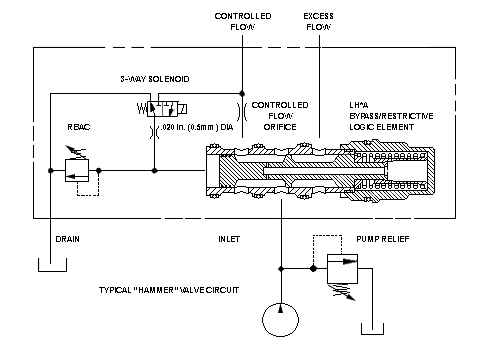Desvió /restrictivo, prioritario elementos de modulación

Bypass/restrictive modulating elements, when combined with an external orifice, create a bypass/restrictive flow control. Input flow (port 3) is directed to the priority or control flow at port 2. Once the priority requirements are met, excess flow is bypassed out port 4. The after-orifice signal is connected to port 1. The before-orifice design allows both pressure and flow to be controlled on the priority side of the circuit regardless of pressure in the bypass circuit. These valves work equally well in either closed or open center systems. Their main use is to allow after-market accessories to be driven off the host machine's hydraulic system without adding an additional pump.
- Bypass flow is not available until priority flow requirements are satisfied.
- Priority flow can be turned on or off with a pilot-sized, three-way solenoid valve on port 1.
- Bypass pressure at port 4 can be higher than pressure at control port 2.
- Cartridges with EPDM seals are for use in systems with phosphate ester fluids. Exposure to petroleum based fluids, greases and lubricants will damage the seals.
- Incorporates the Sun floating style construction to minimize the possibility of internal parts binding due to excessive installation torque and/or cavity/cartridge machining variations.
| cavidad | T-32A |
| Series | 2 |
| Capacity | 30 gpm120 L/min. |
| Maximum Operating Pressure | 5000 psi350 bar |
| Valve Hex Size | 1 1/8 in.28,6 mm |
| Valve Installation Torque | 45 - 50 lbf ft61 - 68 Nm |
| Model Weight | .70 lb0,30 kg |
| Seal kit - Cartridge | Buna: 990032007 |
| Seal kit - Cartridge | EPDM: 990032014 |
| Seal kit - Cartridge | Polyurethane: 990032002 |
| Seal kit - Cartridge | Viton: 990032006 |
There are exactly 250 Sun drops in a cubic inch or 15 in a cc.
The valve was developed originally to power demolition hammers. The hammers are aftermarket accessories that are mounted on a large variety of excavators. The "hammer" circuit provides a method of tapping into the existing hydraulic system of the excavator, turning the tool on and off, controlling flow, and limiting pressure.
Every manufacturer of hammers has very specific needs as far as flow and pressure and there is a large disparity of hydraulic systems in the excavators. For this reason, Sun has never had a catalog package for this circuit.
Sun does not and cannot provide technical support for "hammer valve" installations.
The LH*A family of valves has been optimized to be used in a package to provide a power source for hydraulic tools. We can quantify the performance of the valve in static conditions but we cannot tell you how it will do in your application.
For instance: You want to use the valve as a compensator for a load-sense power steering package. When you are steering the machine and raising an implement, the valve is in a bypass mode (throttling on the bypass side). When the implement actuator bottoms out, pressure jumps to maximum and now the valve needs to change to the restrictive mode. Since the LH*A is balanced against pressure on the bypass side the only thing moving the spool is its own spring. The time this takes is dependent on where the spool was to begin with and where it has to go.
During this transition the steering will see the pressure differential across it suddenly change from about 150 psi (10 bar) to a system pressure of say 3000 psi (200 bar) and suddenly back down to about 150 psi (10 bar). When this scenario was described to me it was termed the broken thumb syndrome.
Sun does not and cannot provide technical support for this type of application. The valve has been successfully used in similar applications. What is necessary to make it work is up to whoever is doing the application.
- Sun Expands Corrosion-Resistant Solutions
- Válvulas y bobinas a solenoides de la serie Sun FLeX
- Sun Offers Zinc-Nickel Plating for Corrosion Resistance
- Sun Cartridges with EPDM Seals
- QuickDesign con SmartConnect Ofrece una Herramienta para Construir Esquemáticos
- Manufacturing Sun Cartridge Cavities (522.27 KB)

